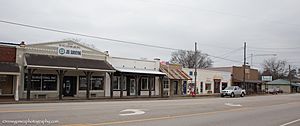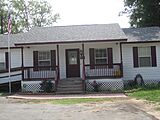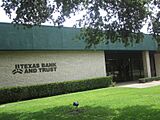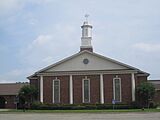Van, Texas facts for kids
Quick facts for kids
Van, Texas
|
|
|---|---|

Downtown Van, Texas
|
|

Location within Van Zandt County and Texas
|
|
| Country | United States |
| State | Texas |
| County | Van Zandt |
| Area | |
| • Total | 2.99 sq mi (7.75 km2) |
| • Land | 2.99 sq mi (7.75 km2) |
| • Water | 0.00 sq mi (0.00 km2) |
| Elevation | 486 ft (148 m) |
| Population
(2020)
|
|
| • Total | 2,664 |
| • Density | 891.0/sq mi (343.74/km2) |
| Time zone | UTC-6 (Central (CST)) |
| • Summer (DST) | UTC-5 (CDT) |
| ZIP code |
75790
|
| Area code(s) | 430, 903 |
| FIPS code | 48-74912 |
| GNIS feature ID | 2412144 |
Van is a city in Van Zandt County, Texas, United States. It is about 26 miles northwest of Tyler. In 2020, 2,664 people lived there. The city is named after Henry Vance, an early settler and school teacher.
Contents
History of Van, Texas
People first settled in the Van area around the time of the Civil War. By 1874, the town was called Swindall. It was named after George Swindall. He gave land for a school and for the Methodist Church.
In 1894, a schoolteacher named Henry Vance started a post office. The town was then renamed Van, after him.
Oil Discovery and Growth
In 1927, the Pure Oil company explored near Van. They found oil on October 13, 1929. The first oil well, Jarman No. 1, produced 147 barrels of oil. This oil came from the Woodbine Formation, about 2,710 feet deep.
Other companies like Sun Oil and Shell Petroleum joined Pure Oil. They all owned the oil field together. Pure Oil was the main company running the operations. By 1994, the Van Field had produced 502 million barrels of oil.
Van quickly became an oil boom town. It grew from a small farming community almost overnight. In just 10 days, 30 new buildings appeared. These included hotels and stores.
In 1930, the Texas Short Line Railway extended to Van. The population stayed around 894 during the 1930s. During World War II, the population dropped to 620. Many workers moved to jobs related to the war. After the war, the population steadily increased.
The number of businesses changed over time. It was highest at 50 in 1934 and lowest at 15 in 1945. Most of the time, there were between 30 and 40 businesses. By the 1950s, Van had an oil refinery, five churches, and a school district. In 1965, the Van oil field had 591 wells. The population grew from 1,103 in 1962 to 1,820 by 1974. By 2013, over 2,600 people lived in Van.
May 2015 Tornado Event
On May 10, 2015, a strong tornado hit Van. It touched down south of Van and moved north. The tornado gained strength as it crossed the Neches River and Interstate 20.
The tornado went right through the center of Van. It caused a lot of damage to buildings. The elementary school, a historic landmark, was destroyed. The tornado then moved through neighborhoods, destroying homes.
It continued north towards Grand Saline. The tornado finally ended 3.5 miles north of Van. Many homes and mobile homes were damaged or destroyed. Trees and power lines were also knocked down. An industrial building and an oil pump derrick were destroyed.
Two people died and 47 were injured. Emergency officials called it a "mass-casualty incident." The next day, the National Weather Service rated the tornado as an EF3 tornado.
Geography of Van
The city of Van covers about 3.0 square miles (7.7 square kilometers) of land. There is no water area within the city limits.
Transportation in Van
Van is served by several important roads:
- Interstate 20 is located south of downtown Van.
- State Highway 110 is known as Maple Street in the city. It goes southeast towards Tyler and north to Grand Saline.
- Farm to Market Road 16 is called Main Street in Van. It runs west towards Canton and east towards Lindale.
- Farm to Market Road 314 is Oak Street. Van is the northern end of this road, which goes south towards Brownsboro.
- Farm to Market Road 1805 connects Van to FM 1253 in nearby Smith County.
Population of Van
| Historical population | |||
|---|---|---|---|
| Census | Pop. | %± | |
| 1950 | 610 | — | |
| 1960 | 1,103 | 80.8% | |
| 1970 | 1,593 | 44.4% | |
| 1980 | 1,881 | 18.1% | |
| 1990 | 1,854 | −1.4% | |
| 2000 | 2,362 | 27.4% | |
| 2010 | 2,632 | 11.4% | |
| 2020 | 2,664 | 1.2% | |
| U.S. Decennial Census | |||
| Race | Number | Percentage |
|---|---|---|
| White (NH) | 2,089 | 78.42% |
| Black or African American (NH) | 55 | 2.06% |
| Native American or Alaska Native (NH) | 7 | 0.26% |
| Asian (NH) | 21 | 0.79% |
| Some Other Race (NH) | 9 | 0.34% |
| Mixed/Multi-Racial (NH) | 108 | 4.05% |
| Hispanic or Latino | 375 | 14.08% |
| Total | 2,664 |
As of the 2020 United States census, there were 2,664 people living in Van. There were 951 households and 710 families.
Education in Van
The Van Independent School District serves the city of Van. It is home to the Van High School Vandals. Many local students also attend Tyler Junior College. This college is part of the local taxing district.
Notable People from Van
- Dan Flynn was a businessman and rancher from Van. He was a Republican member of the Texas House of Representatives.
- Todd Fowler was a professional football player.
- Adrian Hall is a theatre director.
Gallery
-
First United Methodist Church (2012)
See also
 In Spanish: Van (Texas) para niños
In Spanish: Van (Texas) para niños




